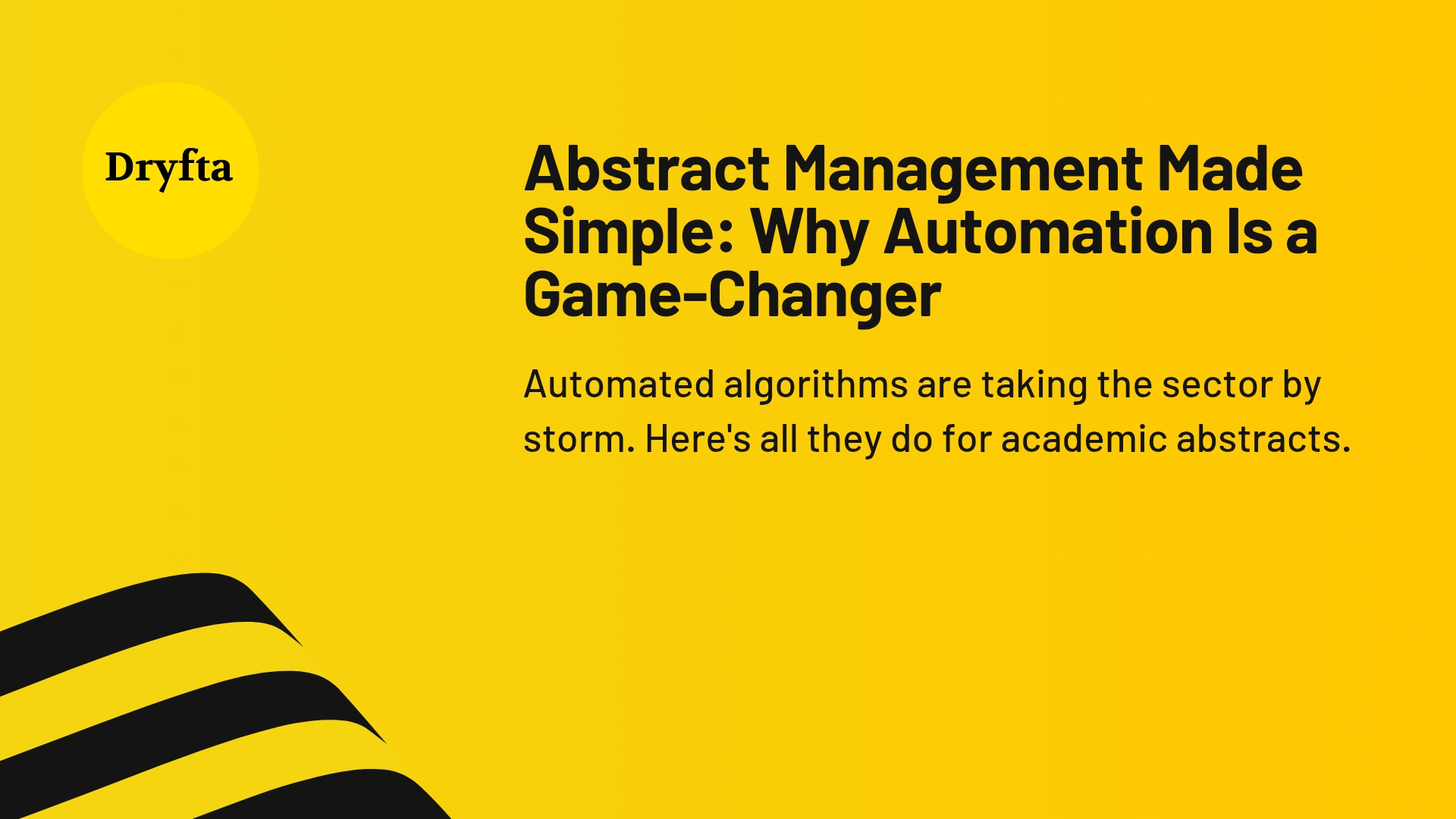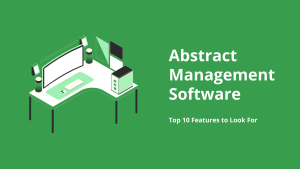
It’s no secret that an academic event planner’s to-do list is ever-growing. Abstract management happens to be one of the many critical aspects of an academic or scientific event. Having access to a reliable abstract management system simplifies collecting, organizing and reviewing abstracts for these events and ensures their success and credibility.
Speaking of abstract management systems, let’s help you get acquainted with Dryfta, our abstract management automation platform.
Since 2014, we’ve remained committed to helping event managers host fruitful academic conferences. We launched Dryfta as an alternative to ‘cash-strapped nonprofits’, organisations that were desperately looking for an all-in-one solution to host their events. Not long after, we made Dryfta accessible to all, and now it is easier than ever to host academic conferences on your own.
A key to our software is and has always been mastering the art of automation. We’ve put our algorithms and software through years and years of testing, retesting and prototyping. And they have never complained.
Our abstract management system exists so event managers like you can unleash your creativity. Leave it to our platform to carry out the repetitive, tedious and mind-numbing tasks.
Abstract Management Powered by Automated software
Abstract management, the system for collecting, reviewing, and organising these submissions, has traditionally been one of the most time-consuming aspects of planning conferences. Anyone who has organised an academic or professional conference knows the weight of abstract management.
The process begins when the call for papers goes out, inviting researchers and professionals to submit their work for consideration. This prompts organisers to take on a number of tasks: tracking submissions as they arrive, ensuring each includes all required information, distributing abstracts to appropriate reviewers, collecting and organising feedback, making acceptance decisions, communicating with hundreds of authors and finally building a coherent programme from accepted submissions.
When handled manually or through basic tools like email and spreadsheets, this process becomes exponentially complex as submission numbers grow. An organiser might receive an abstract via email, manually enter its details into a spreadsheet, save the attached file with a systematic naming convention, forward it to reviewers via separate emails, track reviewer responses in another spreadsheet and then manually compile feedback to make decisions. But thanks to automation, this is a task that can now run in the background as you sleep.
Organising these submissions is no longer a logistical nightmare; we now have access to a streamlined workflow that benefits everyone involved: organisers, reviewers and presenters alike.
The Case for Automation In Abstract Management
Automation in abstract management means more than simply digitising paperwork. Dryfta’s abstract management system, for instance, lets conference organisers create custom submission forms that collect exactly the information they need: author details, abstracts, keywords, presentation preferences and any field-specific requirements. These submissions automatically populate a centralised database where organisers can view, sort and manage all entries without touching a spreadsheet. The system maintains a complete record of each submission.
Streamlining the Review Process
The review process also greatly benefits from automation. When manually done, the review pipeline is like watching paint dry. It’s humdrum, mundane and minute in detailing. For a human to juggle these competing demands is close to impossible, and an obvious consequence of this is making errors. Errors, regardless of their magnitude, can be a serious blow to academic integrity. When the reviewer makes a mistake, often unknowingly, it amounts to a compromise in the quality of the submission.
Organisers have to account for multiple factors when conducting reviews manually. They have to make sure that the submissions were fairly distributed for evaluation amongst their reviewers and double-check if they were adequately evaluated without offending the expertise of the reviewer. These professionals have to keep confidentiality in mind and have the progress consistently tracked so those involved do not slack while working on the tasks.
Manual management of these tasks creates bottlenecks that slow down the entire conference timeline. Automated systems approach this very differently. Organisers can assign submissions to reviewers based on expertise, availability or other criteria. The system automatically sends notifications and provides reviewers with portal access to their assigned abstracts. Reviewers log in to find their assignments waiting, complete with pre-determined evaluation forms. They can review submissions on their own schedule, save partial reviews and submit feedback without having to send a single email.
Dryfta’s features
Dryfta’s abstract management system accounts for some common challenges we’ve tracked over the years. We now solve them by offering the following features:
- Authors can submit abstracts easily through an online form, with all entries automatically saved as they work so nothing is ever lost.
- Organisers can set separate deadlines for each type or track of submission, managing everything from one place.
- The system allows quick auto-assignment of abstracts to reviewers based on pre-set expertise or categories.
- The system allows quick auto-assignment of abstracts to reviewers based on pre-set expertise or categories.
- Dryfta offers a double-blind review option, keeping the process fair by hiding authors’ and reviewers’ identities.
- Accepted abstracts can be shown in a public, searchable archive and collected in an abstract book, ready to share.
- The platform supports uploading many file types (PDF, presentations, audio, video), so authors can attach extra materials.
- Reviewers can discuss abstracts among themselves with built-in discussion tools before they score or provide feedback.
- Authors and reviewers get instant, automatic email updates when submissions or decisions happen. There is no need for manual notifications.
Automation Lets You Collaborate Better
Organising conferences, and particularly managing abstract submissions, seldom falls to a single person. Committees, programme chairs, track coordinators and administrative staff all play important roles in the process. It therefore becomes important for them to work together, for all of their work is looped to each other. When all those involved are human, coordination must be beyond meticulous. So those involved find themselves asking the same questions over and over again:
Who has the most recent version of the submission spreadsheet?
Did the track chair review those borderline abstracts?
Has someone followed up with reviewers who missed the deadline?
Email threads and file-sharing attempts can create confusion rather than coordination.
And more often than not, the responses are also the same. Sometimes, you’re lucky if you get a response. But in the case of automated systems, organisers no longer have to micromanage people into accountability. Automation gives you access to a shared workspace where all team members can view the same information. Role-based access controls make sure that people can do what they need to but without compromising any sensitive information.
Return on Investment
The return on investing in automated abstract management software is clear almost immediately. Automation saves you plenty of time. For volunteer organisers juggling conference planning with other responsibilities, this time savings can make the difference between sustainable workloads and burnout.
Even for paid staff, time saved on administrative tasks becomes time available for higher-value activities like sponsor outreach, programme development or attendee experience improvement. The scalability enabled by automation provides perhaps the strongest long-term return.
Managing 500 submissions takes more time than managing 50, certainly, but not ten times more time. This scalability means conferences can grow without proportionally expanding organising committees or requiring unsustainable volunteer efforts.
A Question to Ponder Upon
The question for conference organisers is not whether automation can improve abstract management; the evidence is clear that it can. The question is whether continuing with manual processes serves your conference’s goals and their own well-being. For most conferences, particularly those with ambitions for growth or quality improvement, the answer points clearly toward automation. The initial investment in settling into automated systems pays dividends in the following ways:
- Saved time
- Reduced stress
- Fewer errors
- Better decisions and
- Improved experiences
As Dryfta’s automated software takes care of the repetitive tasks, the event coordinators can exchange knowledge and novel ideas more effectively.
The Takeaway,
In an era where academic conferences are expected to run seamlessly, adopting an automated abstract management system like Dryfta is the need of the hour. Our solutions empower event organisers to eliminate inefficiencies, minimise errors, and foster better collaboration. Our focus remains steadfastly on innovation, engagement, and delivering exceptional event experiences. This leads to conferences that not only maintain credibility but also inspire growth, learning, and meaningful connections.




